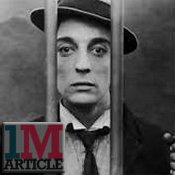In the last of Martin Hafer’s articles covering the stars of yesteryear’s black and white cinema, Buster Keaton’s career is studied.
Buster Keaton was an amazingly funny film comedian. He could take pratfalls better than anyone (hence his nickname) and many of his films are very artistic and are not just based around laughs. Instead, they tell wonderful stories and are quite charming. However, as Keaton had a very long career and also seemed willing to appear in almost ANYTHING, he’s one that you might want a hand to guide you when you look for his films. After all, although he starred in such magnificent comedies as The General, he also appeared in some beach movies in the 1960s! Yes, Keaton was somehow starring with Frankie and Annette—one of the oddest casting choices in film history. And in the film, he’s pretty much wasted if you ask me.
Early in his career, Keaton was a small-time star and it took him a while to get his own films. Many of his earliest films were supporting roles with Roscoe ‘Fatty’ Arbuckle. And, while these films are quite good, they are NOT Keaton films but Arbuckle pictures. However, as Keaton appeared in more and more Arbuckle films, his popularity increased—so much so that he was soon given a chance to star in his own shorts and full-length films. This period in the 1920s is THE prime period for Keaton and here is where you’d find all his hit films. Much of this is because Paramount allowed his full control over his pictures—and he was able to stage amazing stunts (such as in Steamboat Bill Junior) and develop his own particular stone-face character. A few other great films during this time would include The General (mentioned above), Our Hospitality (one of his most artistic films), Seven Chances and Cops.
[widgets_on_pages id=”AdSenseArticleBanner”]
Of course, there are many more wonderful films from this time—and you really cannot do wrong until the late 20s. At this time, Keaton made a fatal decision. In the late 1920s, he left Paramount and their artistic freedom for MGM. While MGM was the biggest and best studio at the time, they had a very difficult time dealing with comics. Laurel and Hardy’s films were released by MGM but they were made by Hal Roach Studios—so they were immune to MGM’s mishandling of comedians in the 1930s. The Marx Brothers, though initially successful with MGM, soon were forced into formulaic and dull films—and Keaton was certainly in the same boat. He no longer was allowed to write or stage his stunts and the films, unfortunately, pushed Keaton to talk more and more—something he wasn’t adept at doing and this was at the expense of his wonderful stunts—which had all but disappeared in the MGM films.
After doing the lackluster film The Cameraman, it got much, much worse. Some bone-head at MGM thought to team Keaton with Jimmy Durante—a fast-talking comic who was the exact opposite of Keaton. They had no chemistry and their films are amazingly bad. After this, MGM blamed Keaton for his films decreasing revenues and relegated him to demeaning tasks—such as directing early music videos called Streamliners. Later, they allowed him a few supporting roles, such as in In The Good Old Summertime. He was fine in the film—but he wasn’t being Keaton. The 1950s and 60s were even worse.
So my advice is look for any Keaton film of the 1920s—they’re all good. You’ll be amazed how funny he is even today and how gifted he was when given a chance to do what he did best. Good luck and let me know what you think.
Article by Lead Entertainment Writer and Film Critic, Martin Hafer






